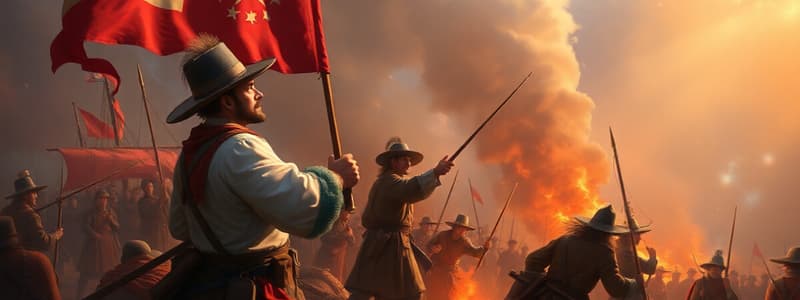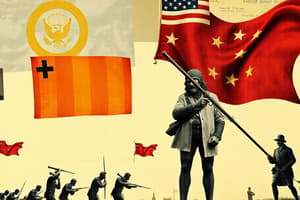Podcast
Questions and Answers
The Monroe Doctrine was a declaration of the United States' intent to avoid involvement in European conflicts.
The Monroe Doctrine was a declaration of the United States' intent to avoid involvement in European conflicts.
False (B)
After the American Revolution, women gained the right to vote and experienced significant educational advancements compared to men.
After the American Revolution, women gained the right to vote and experienced significant educational advancements compared to men.
False (B)
The U.S. became a colonial power following the Spanish-American War, acquiring territories such as Puerto Rico and Guam.
The U.S. became a colonial power following the Spanish-American War, acquiring territories such as Puerto Rico and Guam.
True (A)
Intellectuals believed that the United States was a product of Enlightenment thought primarily due to evolving governmental structures.
Intellectuals believed that the United States was a product of Enlightenment thought primarily due to evolving governmental structures.
The challenges to the family system were one of the reasons Enlightenment thought influenced the formation of the United States.
The challenges to the family system were one of the reasons Enlightenment thought influenced the formation of the United States.
A revolution is a minor change in the established order.
A revolution is a minor change in the established order.
The Boston Tea Party occurred on December 16, 1776.
The Boston Tea Party occurred on December 16, 1776.
Power can be used for both societal benefit and detriment.
Power can be used for both societal benefit and detriment.
The Declaration of Independence was signed prior to the American Revolution.
The Declaration of Independence was signed prior to the American Revolution.
The Industrial Revolution was a crucial turning point in world history.
The Industrial Revolution was a crucial turning point in world history.
The Constitution established a federal system where state and national governments share power.
The Constitution established a federal system where state and national governments share power.
Radicalization is not a common feature of revolutions.
Radicalization is not a common feature of revolutions.
Events of the Counter Reformation are unrelated to the characteristics of the Renaissance.
Events of the Counter Reformation are unrelated to the characteristics of the Renaissance.
George Washington was appointed as commander in chief by the Second Continental Congress.
George Washington was appointed as commander in chief by the Second Continental Congress.
The Bill of Rights guarantees civil rights such as freedom of speech and press.
The Bill of Rights guarantees civil rights such as freedom of speech and press.
Capitalism was not the dominant economic model after the Industrial Revolution.
Capitalism was not the dominant economic model after the Industrial Revolution.
Ideology is a defining factor in the nature of revolutions.
Ideology is a defining factor in the nature of revolutions.
The Treaty of Paris recognized Britain's control over American territories.
The Treaty of Paris recognized Britain's control over American territories.
Spain and France supported the American Revolution by providing supplies and money.
Spain and France supported the American Revolution by providing supplies and money.
The Industrial Revolution necessitated a change in agricultural methods.
The Industrial Revolution necessitated a change in agricultural methods.
The federal government in the proposed Constitution is comprised of four branches: executive, legislative, judiciary, and military.
The federal government in the proposed Constitution is comprised of four branches: executive, legislative, judiciary, and military.
Leonardo da Vinci was not considered an important figure between the Renaissance and the French Revolution.
Leonardo da Vinci was not considered an important figure between the Renaissance and the French Revolution.
The American Revolution occurred between 1775 and 1783.
The American Revolution occurred between 1775 and 1783.
The Stamp Act required printed materials to be tax-exempt in the colonies.
The Stamp Act required printed materials to be tax-exempt in the colonies.
Marie Antoinette and Napoleon Bonaparte are often mentioned as significant historical figures during the period leading up to the French Revolution.
Marie Antoinette and Napoleon Bonaparte are often mentioned as significant historical figures during the period leading up to the French Revolution.
The Navigation Acts allowed the colonies to sell key products to any country besides Great Britain.
The Navigation Acts allowed the colonies to sell key products to any country besides Great Britain.
The Declaratory Act asserted Parliament's authority to tax the colonies.
The Declaratory Act asserted Parliament's authority to tax the colonies.
Humanism played no role in the period between the Renaissance and the French Revolution.
Humanism played no role in the period between the Renaissance and the French Revolution.
The class presentation must last between 1 and 1.5 minutes.
The class presentation must last between 1 and 1.5 minutes.
Flashcards
Revolution
Revolution
A significant change in existing order, often involving government and social systems.
Triggers of Revolution
Triggers of Revolution
The reasons driving organized movements for change, including economic, technological, political, or social shifts, when people see established systems as failing.
Common Features of Revolutions
Common Features of Revolutions
Characteristics of revolutionary movements, including ideology, flashpoints, armed struggle, power grabs, and aftermath of conflict.
American Revolution
American Revolution
Signup and view all the flashcards
Power (as a tool)
Power (as a tool)
Signup and view all the flashcards
Industrial Revolution
Industrial Revolution
Signup and view all the flashcards
Navigation Acts
Navigation Acts
Signup and view all the flashcards
Seven Years' War
Seven Years' War
Signup and view all the flashcards
Capitalism
Capitalism
Signup and view all the flashcards
Stamp Act
Stamp Act
Signup and view all the flashcards
Historical Figures
Historical Figures
Signup and view all the flashcards
Renaissance to French Revolution
Renaissance to French Revolution
Signup and view all the flashcards
Declaratory Act
Declaratory Act
Signup and view all the flashcards
Historical Figure Presentation
Historical Figure Presentation
Signup and view all the flashcards
Colonial Resistance
Colonial Resistance
Signup and view all the flashcards
Personal Sentiments & Societal Revolution
Personal Sentiments & Societal Revolution
Signup and view all the flashcards
Boston Tea Party
Boston Tea Party
Signup and view all the flashcards
First Continental Congress
First Continental Congress
Signup and view all the flashcards
Declaration of Independence
Declaration of Independence
Signup and view all the flashcards
American Revolution
American Revolution
Signup and view all the flashcards
Federal System
Federal System
Signup and view all the flashcards
Three Branches of Government
Three Branches of Government
Signup and view all the flashcards
Bill of Rights
Bill of Rights
Signup and view all the flashcards
Individual Rights
Individual Rights
Signup and view all the flashcards
Enlightenment Thought & US Formation
Enlightenment Thought & US Formation
Signup and view all the flashcards
Post-Revolution Challenges
Post-Revolution Challenges
Signup and view all the flashcards
Monroe Doctrine
Monroe Doctrine
Signup and view all the flashcards
Spanish-American War & Colonialism
Spanish-American War & Colonialism
Signup and view all the flashcards
American Colonization Effect
American Colonization Effect
Signup and view all the flashcards
Study Notes
General Information
- The documents appear to be study notes or lecture slides on revolutions, specifically the American Revolution.
American Revolution
- The American Revolution occurred between 1775 and 1783.
- The US was formed in 1776 comprising 13 British colonies.
- Key colonies include Virginia (founded 1607).
- The Navigation Acts forbade the colonies from selling key American goods to other countries except Great Britain.
- These acts aimed at covering war costs incurred by Britain.
The Spark of the Revolution
- Britain sought to increase revenue from the colonies to offset war costs.
- The Stamp Act (1766) necessitated a tax stamp on printed materials, sparking colonial resistance and its eventual repeal.
- The Declaratory Act of 1766 asserted Parliament's authority to tax the colonies.
- Taxes were subsequently imposed on items like glass, paper, lead, and tea, before all but the tea tax were repealed.
- The Boston Tea Party (December 16, 1773) saw individuals, some disguised as Indigenous Americans, dump 342 chests of tea into Boston Harbor, as a form of protest.
- The First Continental Congress urged taking up arms and rallying under "No Taxation Without Representation."
The American Revolution - Key Events and Outcomes
- The Second Continental Congress appointed George Washington as commander-in-chief.
- The Declaration of Independence, signed and validated, legitimized the American Revolution.
- France provided aid—supplies and financial support—to the colonists and their army.
- Britain was defeated, and the Treaty of Paris recognized American independence.
After the Revolution
- Congress faced challenges uniting the states, which clashed frequently.
- Despite initial progress, women generally had fewer freedoms, including less schooling and no voting rights.
- Colonial America faced various challenges, including religious differences and economic disparities.
American Imperialism
- The Monroe Doctrine (1823) declared the Western Hemisphere under US influence.
- The Spanish-American War (late 1800s) resulted in the US acquiring colonies including the Philippines, Puerto Rico, Guam, and Samoa.
Assessments & Assignments
- Tasks like creating, analyzing images, & presentations related to historical figures and revolutions are mentioned.
- A character portrayal assessment focusing on figures from the Renaissance to the French Revolution is noted.
- Students need to research the figure's life, achievements, impacts—with costumes and props.
- Other tasks include analyzing images, Venn Diagrams, and understanding fundamental concepts related to revolutions.
Studying That Suits You
Use AI to generate personalized quizzes and flashcards to suit your learning preferences.




